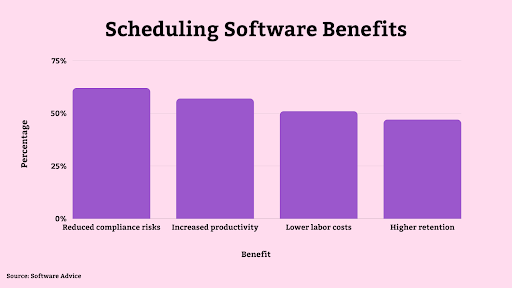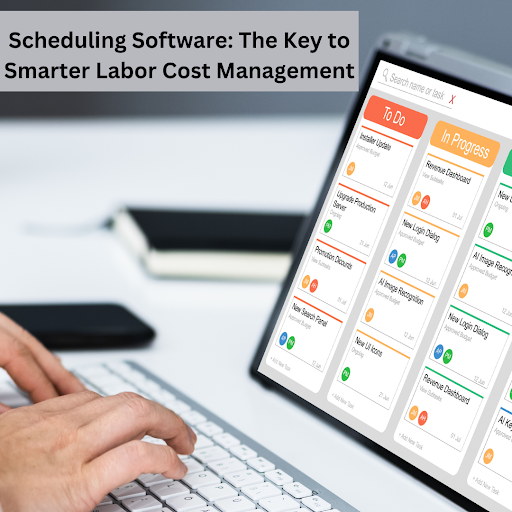For many leaders, cutting costs without crushing morale seems like chasing a mythic golden goose. Personnel accounts for up to 30% of operating expenses, so businesses are hungry for optimization. Enter scheduling software – the game-changing solution bringing smarter labor cost management from fantasy to reality. This isn’t just a tool for slashing expenses. It also promotes work-life balance, productivity, and retention. Companies using scheduling software reduce labor costs by up to 25% versus manual methods (ATOSS). But benefits extend further. Optimized schedules mean happier teams and higher engagement – a double win for finances and people. Scheduling software provides that rare golden egg – optimizing labor spend while keeping employees happy and empowered. The numbers prove it streamlines expenses and chaos. The statistics speak volumes, but what does next-level workforce management look like? Let’s take a closer look at the key to smarter labor cost management.
Create an online Community Website
Checkout BuddyX Theme Demos
Buy the BuddyX Pro theme and Community Bundle Addons and create a highly engaging community platform Today!

Table of Contents
ToggleThe Significance of Labor Costs in Business Operations
Labor costs are one of the primary expenses for businesses, especially in the service sector. Efficient management of staff can reduce overtime, absenteeism, and turnover, leading to significant cost savings. As businesses grapple with the weight of labor costs, it’s essential to understand the challenges they face. With the projection that 2.1 million manufacturing jobs will remain unfilled by 2030, the importance of efficient labor management becomes even more evident.
While understanding the significance of labor costs is crucial, the methods used to manage these costs are equally important. Traditional scheduling methods have their pitfalls, but modern solutions offer a way forward.
Key to Smarter Labor Cost Management
Effective management of labor costs is crucial for sustainable growth and productivity. This begins with the implementation of advanced scheduling software.
1. Accuracy and Transparency with Scheduling Software

Schedules software can help avoid errors and conflicts that arise from manual or outdated scheduling methods. Automation, integration, and alerts ensure schedules are accurate, consistent, and compliant with labor laws. With 81% of hourly workers preferring mobile access to their schedules, the demand for transparency and accuracy has never been higher.
2. Data Source: Software Advice- Scheduling Software
While scheduling software automates and optimizes the creation of employee schedules, having a well-designed weekly schedule template is still important for effectively planning and communicating shifts. A good template structures the schedule in a clear, organized way while including key details like employee names, times, and locations. Businesses can download a weekly schedule template and customize it to suit their needs before uploading it into their scheduling system.
Also Read: Why Create An Online Community?
3. Enhancing Flexibility and Communication
Scheduling software allows for quick and easy adjustments to schedules, accommodating changing demands and worker availability. Real-time communication features eliminate the communication gap between managers and employees, with 76% of workers valuing the ability to trade shifts. This flexibility not only ensures operational efficiency but also boosts morale and satisfaction among staff.
Flexibility and communication are essential for day-to-day operations, but the long-term success of a business hinges on its ability to align its workforce with its broader goals and objectives.
3. Boosting Productivity and Performance
Scheduling software allows businesses to align their schedules with organizational goals and metrics. With 80% of hourly workers stating that their schedules influence their quality of work, it’s clear that the right scheduling tools can significantly boost productivity. By optimizing schedules based on demand, capacity, and budget, businesses can ensure they’re getting the most out of their workforce.
While productivity is a key outcome, the true testament to the effectiveness of scheduling software is its impact on employee engagement and retention. After all, a satisfied and engaged employee is a productive one.
4. Analyzing Data and Trends for Informed Decisions
Data-driven insights are key for businesses looking to optimize their labor costs in the long run. Scheduling software provides valuable data through dashboards, charts, and reports that enable the identification of inefficiencies and opportunities for improvement. Analyzing trends in demand, capacity, budgets, and other metrics allows managers to make data-backed scheduling decisions to refine labor cost management.
5. Promoting Employee Engagement and Retention
Engaged and satisfied employees are more likely to be productive, provide better services, and remain loyal to the company. Scheduling software allows managers to respect staff availability, preferences, and work-life balance. Features like self-service, shift swapping, and easy PTO management empower employees and make them feel valued. This drives engagement, reduces turnover, and lowers recruitment costs.
6. Ensuring Compliance with Laws and Regulations
Businesses must remain compliant with labor laws and regulations around scheduling to avoid penalties. Scheduling software helps ensure compliance by tracking hours worked, enforcing break and rest times, preventing overscheduling, and sending reminders about compliance issues. This protects both the business and its employees.
7. Forecasting and Budgeting for Future Success
To optimize labor costs long-term, businesses need to forecast and budget effectively. Scheduling software uses historical data, trends, and projections to predict ideal staffing levels and labor budgets. This enables managers to strategically plan and control costs over time.
Also Read: Top 10 Trending Social Media Management Tools For Your Businessn
8. Accessing Expert Training and Support
Adopting new technology can be daunting without proper guidance. Reputable scheduling software providers offer stellar training and 24/7 support to ensure a smooth implementation. This allows businesses to get maximum value out of the system quickly and painlessly.
The bottom line? Scheduling software gives businesses a multifaceted toolkit to transform labor cost management from a constant struggle into a strategic advantage. Satisfy stakeholders without sacrificing employee satisfaction – that’s the golden goose today’s leaders are searching for.
Key Takeaways
Scheduling software provides accuracy, agility, and insights to transform labor cost management. Its workforce optimization meets employee empowerment.
This technology not only drives productivity and cost savings, but also increases employee engagement, satisfaction, and retention. A win-win for both business and people.
Companies that leverage scheduling software gain a strategic advantage in controlling labor expenses while cultivating a thriving, empowered workforce.
Final Thoughts on Scheduling Software
The data paints a compelling picture – scheduling software is a game-changer for labor cost management. The bottom-line benefits are clear: reduced compliance risks, improved productivity, and significant cost savings. But this technology’s impact extends far beyond dollars and cents. It nurtures work-life balance, flexibility, and empowerment for employees. And nothing engages a workforce like feeling truly valued.
So while the numbers are convincing, we must remember the hearts and minds scheduling software also touches. Because an inspired, loyal team is any business’ most valuable asset.
Yes, this technology optimizes costs like nothing else. But it also unlocks something even greater – a culture of engagement where both business and employees thrive. And that’s the true golden goose every organization seeks.
Frequently Asked Questions- Scheduling Software
- How does scheduling software ensure compliance with labor laws and regulations?
Scheduling software can track hours worked, enforce break times, prevent overscheduling, and send alerts about potential compliance issues. This helps businesses remain compliant and avoid costly violations. - How does scheduling software help in reducing recruitment costs?
By promoting work-life balance, empowering employees, and driving engagement, scheduling software reduces employee turnover. Lower turnover means businesses save on continual recruitment and onboarding costs. - What are the potential risks and inefficiencies that can be mitigated using scheduling software?
Scheduling software helps avoid issues like overstaffing, understaffing, excessive overtime, compliance risks, miscommunication, and disjointed workflows that result in higher labor costs.
Interesting Reads:
How to Set Your Marketing Objectives and Get More Sales






